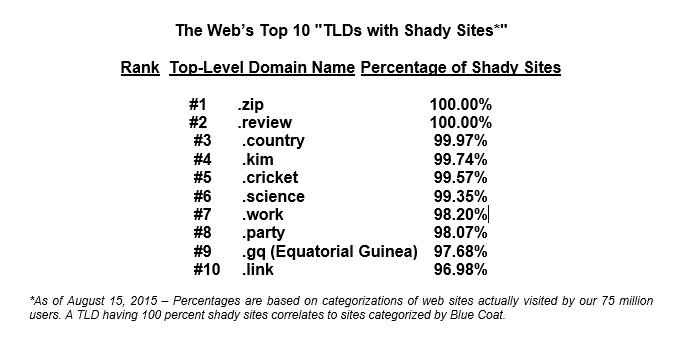KUALA LUMPUR, 4 September 2015: If you’ve been wondering whether your website domain is safe, wonder no more with Blue Coat’s The Web’s Shadiest Neighborhoods report.
Blue Coat Systems, Inc., a market leader in enterprise security, today revealed new research for consumers and businesses that shows the Top-Level Domains (TLDs), or “neighborhoods,” most associated with suspicious websites.
Having analysed over hundreds of millions of Web requests from more than 15,000 businesses and 75 million users worldwide, Blue Coat’s latest report revealed that more than 95 percent of websites in 10 different TLDs are rated as suspicious, with that percentage increasing to 100 percent for the top two highest ranking TLDs, .zip and .review.
A domain was counted as “shady” if it was rated in its database with a category such as:
(a) Most Common Malicious Activity
- Spam
- Scam
- Suspicious
- Potentially Unwanted Software (PUS)
(b) Less Common Malicious Activity
- Malware
- Botnet
- Phishing
Domains in the database that were not classified in one of these ways were counted as “non-shady.”
Recent Risky Activity from the Web’s Shadiest Neighborhoods
The report also reveals examples of nefarious activity taking place on shady websites of some of the top ranked Shady TLDs, including the fourth most seemingly dangerous neighborhood, .kim. Blue Coat researchers recently discovered websites serving up pages which mimic popular video and image sites and prompt unprotected visitors to unwittingly download malware.
“Due to the explosion of TLDs in recent years, we have seen a staggering number of almost entirely shady Web neighborhoods crop up at an alarming rate,” said Kenneth Chen, Blue Coat Managing Director for ASEAN, Hong Kong & Taiwan. “The increase in Shady TLDs as revealed by Blue Coat’s analysis is in turn providing increased opportunity for the bad guys to partake in malicious activity. In order to build a better security posture, knowledge about which sites are the most suspicious, and how to avoid them, is essential for consumers and businesses alike.”
Minimizing the Risk for Businesses and Consumers
As organizations and consumers look to safeguard themselves against these shady TLDs, they can draw key lessons from the report to inform and strengthen their security posture, including:
- Businesses should consider blocking traffic that leads to the riskiest TLDs. For example, Blue Coat has previously recommended that businesses consider blocking traffic to .work, .gq, .science, .kim and .country.
- Users should use caution to click on any links that contain these TLDs if they encounter them in search results, e-mail, or social network environments.
- If unsure of the source, hover the mouse over a link to help verify that it leads to the address displayed in the text of the link.
- “Press and Hold” links on a mobile device (not just click) to verify it leads where it says it does.





